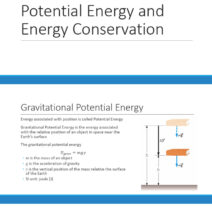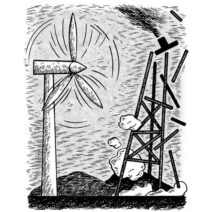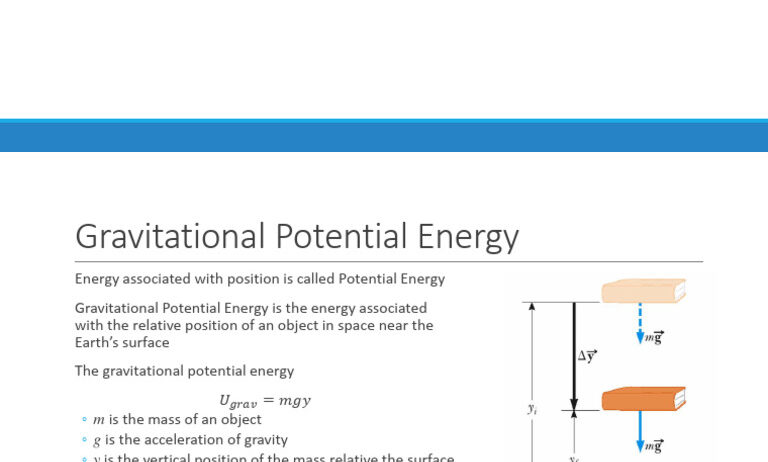Understanding the concept of potential energy in physics is not merely an academic endeavor; it delves into the heart of numerous phenomena observed in nature. At its core, potential energy represents the stored energy in an object due to its position or state. This intrinsic energy becomes significant when elucidating the principles of conservation of energy, which posits that energy cannot be created or destroyed, only transformed from one form to another.
To navigate the intricacies of potential energy, it is imperative first to define it clearly. Potential energy is commonly associated with the position of an object in a gravitational field, elastic deformation, or even electrical charge configuration. The most familiar form, gravitational potential energy (GPE), can be articulated mathematically as:
GPE = mgh
where m represents mass, g denotes acceleration due to gravity, and h signifies height above a reference point. This equation highlights the direct relationship among mass, gravitational force, and height, thereby accentuating how potential energy increases with greater height or mass.
One common observation that invites curiosity is how potential energy seemingly converts to kinetic energy during the descent of an object. Consider a straightforward scenario: a ball is held at a certain height before being released. As the ball falls, its potential energy diminishes while its kinetic energy—increased motion—grows. This harmonious transition exemplifies the conservation of energy principle, wherein the total mechanical energy remains constant in an ideal system devoid of frictional forces.
In a more complex system, potential energy begins to intertwine with various forms of energy, particularly in the realms of hydroelectric power generation and roller coasters. In hydropower, large volumes of water accumulate in a reservoir, storing immense gravitational potential energy. When released, this potential energy transforms into kinetic energy, facilitating the generation of electricity. Similarly, roller coasters, designed with the artistry of physics, meticulously calculate elevations that harness potential energy at peak heights, ensuring exhilarating drops that convert it into kinetic energy, thrilling riders with exhilarating speeds.
However, potential energy is not confined to gravitational contexts. Elastic potential energy manifests in objects such as springs or rubber bands. When these materials are deformed, energy is stored within the structure as it resists reformation. The formula for elastic potential energy is articulated as:
EPE = 1/2 kx²
In this equation, k symbolizes the spring constant, quantifying the stiffness of the spring, and x represents the displacement from the equilibrium position. The quadratic relationship between displacement and stored energy reveals that small changes in displacement can engender substantial energy variations. This principle is especially significant in applications such as catapults and archery, where elastic energy can be harnessed efficiently.
Maximizing comprehension of potential energy requires a nuanced understanding of conservation principles. The law of conservation of energy is quintessential; it enables the transition between forms of energy—potential and kinetic—while stressing that the total energy remains invariant in a closed system. An illustration of this can be observed in a pendulum’s motion. At its peak, when momentarily motionless, the pendulum harbors maximum potential energy. As it swings downward, this potential energy translates into kinetic energy until it reaches its nadir, where kinetic energy peaks. Rarely does energy escape the system unless external forces, such as air resistance or friction, are at play.
The implications of understanding potential energy extend beyond mere educational curiosity. These principles relate directly to real-world challenges, offering insights into optimizing energy systems and improving efficiency in numerous engineering designs. By applying these mathematical and conceptual frameworks, environmentalists and engineers can devise solutions that harness gravitational and elastic energies for renewable energy sources.
The academic pursuit of potential energy reveals a deeper fascination with the interconnectedness of physical laws. It inspires inquiries about the energetic balance of natural ecosystems and the role of energy transformations within biological systems. For example, photosynthesis epitomizes energy transformation processes: sunlight, captured by plants, initiates chemical energy storage, which is later released and transformed within various food webs. While plants utilize solar energy to generate potential energy in chemical bonds, animals subsequently convert this potential energy into kinetic energy for movement. This cyclical energy flow underscores the significance of energy conservation across species, further implicating it in discussions about sustainability and ecological balance.
As we tread further into the energy transition towards sustainable practices, understanding potential energy’s role becomes increasingly crucial for addressing climate change. Investments in technology that leverage gravitational and elastic potential energy can mitigate fossil fuel dependencies, moving society toward a more sustainable and resilient framework.
In conclusion, grasping the concept of potential energy through the lens of conservation of energy principles opens broader dialogues about the intricate interplay of energy in both natural and engineered systems. The study of potential energy in physics resonates not only within the scientific community but also in the broader quest for sustainable living. By examining the foundational principles and their real-world applications, a deeper appreciation for energy conservation emerges, awakening a greater conscientiousness regarding our ecological footprint.






